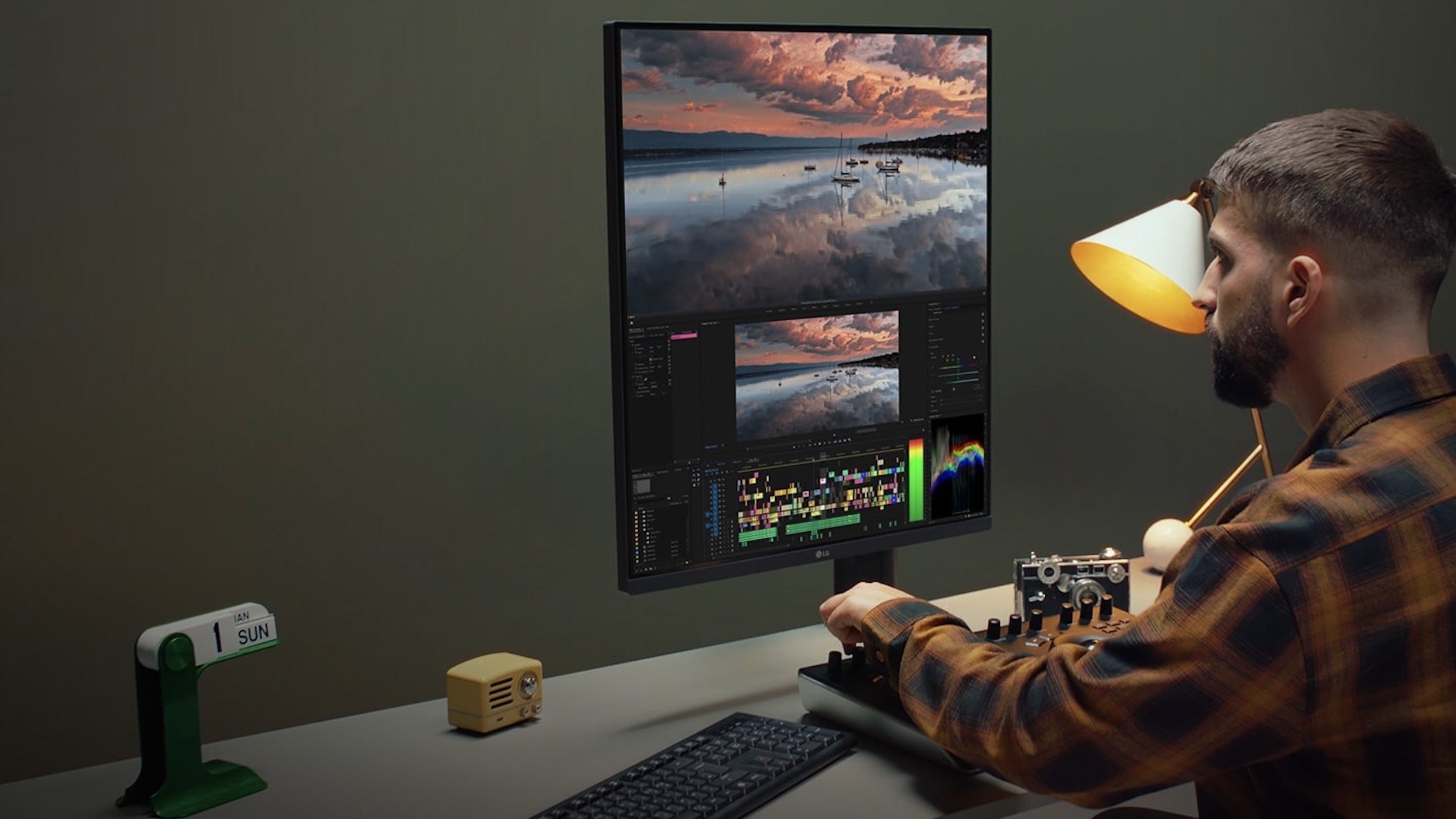The Origins of the Rectangular Screen
The rectangular shape has become synonymous with computer monitors and has become the standard in the tech industry. But have you ever wondered why rectangular screens have become so prevalent? Let’s explore the origins of this popular screen shape.
In the early days of computer technology, screens were not standardized and came in various shapes and sizes. However, as technology advanced and the need for more efficient displays emerged, a standardized shape became necessary.
The rectangular screen shape gained popularity due to its practicality and compatibility with other aspects of computer design. The width-to-height ratio of the rectangle allows for optimal use of screen real estate and fits well with the upright orientation of most computer hardware.
The transition to rectangular screens also became necessary as graphical user interfaces (GUIs) became more prevalent in computing. The rectangular shape was better suited for the display of graphical elements, such as icons and windows, which are a fundamental part of the modern computing experience.
Furthermore, the rectangular shape allowed for more straightforward and efficient coding and design. Programming languages and graphical toolkits are typically designed with rectangular coordinate systems in mind, making it easier to work with rectangular screens.
As the computer industry evolved, manufacturers began to adopt the rectangular shape as the industry standard for monitors and displays. This standardization brought benefits for both manufacturers and consumers.
For manufacturers, the use of a standardized shape means that production processes can be streamlined, leading to cost savings and increased efficiency. It also means that components, such as display panels, can be produced in larger quantities, further reducing costs.
For consumers, the adoption of a standardized shape means that a wider range of monitors and displays are readily available at affordable prices. This allows for greater flexibility when choosing a monitor that suits individual needs, whether it be for work or leisure.
The Evolution of Square Screens
While rectangular screens have become the industry standard, square screens were once a prevalent option in the early days of computing. Let’s take a closer look at the evolution of square screens and why they have largely been replaced by rectangular ones.
In the early days of computing, square screens were commonly used due to technical limitations and design considerations. These square screens provided a balanced display area and were easier to manufacture. However, as technology advanced and new possibilities emerged, the focus shifted towards rectangular screens.
One of the key reasons for the transition from square to rectangular screens was the increasing demand for widescreen content. The entertainment industry, particularly movies and television, started adopting widescreen formats, leading to a shift in consumer preferences. Rectangular screens could better accommodate widescreen content, providing a more immersive viewing experience.
Another factor that contributed to the evolution of square screens was the rise of graphical user interfaces (GUIs). GUIs revolutionized the way users interacted with computers by introducing icons, windows, and graphical elements. Rectangular screens proved to be more conducive to displaying GUI elements, allowing for better usability and enhanced visual presentation.
Additionally, the adoption of rectangular screens enabled better utilization of screen space for multitasking. With the growing demand for productivity, users wanted to have multiple applications and windows open simultaneously. Rectangular screens offered a wider horizontal real estate, facilitating side-by-side viewing and improved multitasking capabilities.
Moreover, the emergence of new display technologies and manufacturing advancements played a significant role in the transition from square to rectangular screens. LCD screens, for example, became popular due to their energy efficiency, lightweight design, and ability to produce vibrant colors. Manufacturing these LCD panels in rectangular shapes became more practical and cost-effective, leading to their widespread adoption.
It’s important to note that while square screens have become less prevalent, they still find applications in certain areas. For example, some specialized industries, such as graphic design and photography, value the square aspect ratio for its symmetry and compatibility with certain artistic principles. Additionally, square screens can still be found in some older devices or retro-inspired products that aim to evoke a sense of nostalgia.
The Advantages of Square Screens
Although rectangular screens have become the norm in the tech industry, it’s worth exploring the advantages that square screens offer. While they may not be as prevalent as their rectangular counterparts, square screens can provide a unique set of benefits in certain contexts.
One of the key advantages of square screens is their symmetry. Unlike rectangular screens, which have a wider horizontal display area, square screens offer equal width and height. This symmetry can be visually appealing and provide a balanced viewing experience, especially when dealing with content that is inherently square or has a square aspect ratio.
Square screens also have their advantages when it comes to certain types of content, such as documents and websites. Since many documents and web pages are designed to fit a standard letter-sized or A4 paper, square screens can display these types of content without any cropping or distortion. Users can view full pages with ease, making reading and editing documents a more convenient task.
Another advantage of square screens is their suitability for certain creative tasks, such as graphic design and photo editing. The square aspect ratio provides a more accurate representation of many artistic works and allows artists to evaluate their compositions in a way that aligns with traditional artistic principles. This can be particularly valuable when working with symmetrical or evenly balanced compositions.
Furthermore, square screens can enhance the gaming experience in certain genres. Games that have square or vertically oriented visuals, such as retro arcade games or puzzle games, can be better enjoyed on a square screen. The square format allows for a more immersive and authentic experience, as the game’s original design and intended aspect ratio are preserved.
In addition to content compatibility and visual aesthetics, square screens offer practical advantages as well. For example, square screens can make it easier to organize and manage multiple applications or windows simultaneously. The equal width and height of the screen allow for more efficient use of space, facilitating multitasking and boosting productivity.
It’s worth mentioning that square screens may not be as widely available or standardized as rectangular screens in today’s market. However, for individuals who value the unique benefits they offer, there are still options available. Some specialized monitors or display solutions cater specifically to those who seek the advantages of square screens.
Multi-tasking Made Easier
One of the significant advantages of square screens is their ability to make multitasking easier and more efficient. The equal width and height of a square screen provide a balanced and symmetrical display, allowing users to manage multiple applications and windows with greater ease.
When working on tasks that require frequent switching between different applications or referencing multiple sources simultaneously, a square screen can offer a more seamless experience. With a square screen, you can have two applications or windows open side by side, dividing the screen into two equal halves. This arrangement enables you to view and work on both pieces of content simultaneously, without sacrificing visibility or the need for excessive scrolling.
The equal width and height of a square screen also provide better visibility for comparing and cross-referencing information. For tasks that involve comparing data or analyzing visual elements side by side, a square screen allows for a more natural and comfortable viewing experience. This can be particularly useful in fields such as financial analysis, data visualization, and web design, where the ability to view multiple elements at once is crucial.
Moreover, the square screen format is ideal for users who work with vertical or portrait-oriented content. Documents, spreadsheets, and web pages that are oriented vertically can be displayed with their full height on a square screen. This means that you don’t have to constantly scroll up and down to view a full document, providing a more efficient and intuitive workflow.
In addition to productivity benefits, square screens can also enhance collaboration. When working in teams or sharing screens during presentations, a square screen can offer a more equitable and inclusive viewing experience. The equal width and height ensure that everyone in the room has a clear view of the content, reducing the need to zoom in or out to fit within a rectangular frame.
It’s important to note that while rectangular screens have dominated the market, there are still options available for those who prefer square screens. Some manufacturers offer monitors with adjustable stand features that allow users to switch between portrait and landscape orientations, providing the flexibility to enjoy the benefits of both formats.
Whether you’re a professional in need of efficient multitasking capabilities or someone who appreciates the balance and symmetry of a square screen, the advantages it offers can greatly enhance your computing experience.
Better Organization of Information
One of the significant advantages of square screens is their ability to facilitate better organization of information. The equal width and height of a square screen provide a balanced and symmetrical display, allowing for a more efficient and intuitive arrangement of content.
When working with a square screen, users have the advantage of being able to divide the screen space into equal sections or grids. This division allows for a more systematic organization of windows, applications, and documents. With a square screen, you can easily allocate specific sections for different tasks or types of information, creating a visually organized workspace.
The balanced display of a square screen also ensures that no content is unnecessarily compressed or distorted. This balanced viewing experience can be particularly beneficial when working with large spreadsheets, complex diagrams, or detailed visual presentations. Having all the information displayed in a clear and uncluttered manner allows for easier comprehension and analysis.
Furthermore, a square screen enables users to view and work with vertical or portrait-oriented content in its entirety. Documents, web pages, or images that are designed for a portrait orientation can be displayed without the need for excessive scrolling or losing valuable screen real estate. This comprehensive view of vertical content improves readability, reduces eye strain, and enhances overall productivity.
The equal width and height of square screens also make them ideal for tasks that involve side-by-side comparison or parallel processing. By splitting the screen into two or more sections, users can have multiple documents, applications, or web pages open simultaneously. This arrangement allows for more efficient multitasking, effortless cross-referencing, and smoother workflow transitions.
In addition to dividing the screen space, square screens can also facilitate better organization within individual applications or software. With a balanced display area, software developers and designers can optimize interfaces and layouts, ensuring that important tools and features are easily accessible without cluttering the screen. This attention to organization and usability can improve user experience and workflow efficiency.
Although rectangular screens have become the norm in the tech industry, square screens still offer unique advantages when it comes to organizing and managing information. Whether you’re a professional working with complex data or an average computer user seeking a more visually organized workspace, the balanced display of a square screen can significantly enhance your productivity and overall computing experience.
Enhanced Gaming Experience
When it comes to gaming, the display plays a crucial role in delivering an immersive and satisfying experience. While rectangular screens dominate the market, square screens can offer a unique advantage when it comes to gaming, particularly in certain genres and use cases.
One of the notable advantages of square screens for gaming is their ability to maintain the original aspect ratio of older games. Many classic arcade games, retro-inspired titles, and pixel art games were developed with a square aspect ratio in mind. Playing these games on a square screen can provide a more authentic experience, preserving the intended visual proportions and avoiding distortion or cropping.
Moreover, square screens can enhance the gaming experience for genres that utilize vertically oriented visuals. Games like shoot ’em ups, vertical scrolling shooters, and puzzle games often feature gameplay that is designed to take advantage of the vertical space. Square screens allow these games to be displayed in their intended aspect ratio, resulting in a more immersive and enjoyable gaming experience.
Additionally, square screens can offer a more balanced and centered view in certain gaming scenarios. Some first-person shooter (FPS) games or strategy games rely heavily on a balanced perspective, with critical information displayed on both sides of the screen. With a square screen, players can have a more symmetrical and evenly distributed viewing experience, reducing the need for constant eye movement and potentially improving reaction times.
Furthermore, square screens can be beneficial for multiplayer and local co-op gaming. When playing with friends or family members, a square screen can provide a more equitable viewing experience, ensuring that everyone has an equal and unobstructed view of the game. This can be particularly useful for games that involve split-screen gameplay, as players can have their portion of the screen without feeling cramped or disadvantaged.
Although rectangular screens have become the standard in the gaming industry, square screens still have their niche in delivering a unique gaming experience. While square screens may not be as readily available, some gaming monitors or display solutions offer the flexibility to switch between portrait and landscape orientations, allowing gamers to enjoy the best of both worlds.
Whether you’re a fan of classic arcade games, vertically oriented genres, or prefer a more symmetrical display, the enhanced gaming experience that square screens offer can bring a new level of immersion and enjoyment to your gaming sessions.
Simplified Design and Aspect Ratios
When it comes to design and aspect ratios, square screens can offer unique advantages that simplify the creative process and enhance visual aesthetics. While rectangular screens dominate the market, square screens provide a more symmetrical canvas for designers and offer benefits in various design-related applications.
One of the primary advantages of square screens in design is their symmetrical nature. The equal width and height of a square screen create a harmonious and balanced visual presentation, which can be especially appealing for artistic and creative endeavors. Whether designing logos, posters, or website layouts, the symmetrical canvas of a square screen allows for a more aesthetically pleasing arrangement of elements.
Moreover, square screens simplify the aspect ratio dilemma that designers often face. With rectangular screens, designers have to juggle multiple aspect ratios and consider how their designs will translate across different devices and screen sizes. In contrast, square screens have a single aspect ratio, eliminating the need to adapt designs for different orientations or aspect ratios. This simplification allows designers to focus more on the creative aspects of their work, rather than worrying about the technical challenges of aspect ratios.
Another advantage of square screens in design is their compatibility with certain artistic principles. Many art forms, such as painting and photography, often adhere to the rule of thirds or other compositional guidelines based on a square or symmetrical grid. Designing with a square screen enables designers to work in harmony with these principles, as the canvas aligns naturally with the desired composition.
Furthermore, square screens can enhance the presentation of certain visual content, such as galleries or portfolios. Displaying images in a grid layout on a square screen allows for a consistent and organized presentation. Each image can have equal prominence and be showcased without cropping or resizing, ensuring that the original intent of the artwork is preserved.
It’s worth noting that while rectangular screens are prevalent, the design world still values the benefits that square screens offer. Some design software and tools provide options for working in a square aspect ratio, ensuring that designers can enjoy the advantages of a balanced canvas. Additionally, some specialty monitors or display solutions cater specifically to designers, offering square screen options that facilitate a simplified and aesthetically pleasing design process.
Whether you’re a graphic designer, photographer, or artist, the simplified design process and balanced aspect ratio that square screens provide can elevate your creative work and enhance the visual impact of your designs.
Increased Productivity and Efficiency
When it comes to productivity and efficiency, the screen you use plays a vital role in your workflow. While rectangular screens dominate the market, square screens can offer unique advantages that contribute to increased productivity and efficiency in various contexts.
One of the key advantages of square screens is the ability to display more content at once. The equal width and height of a square screen allow for a more efficient use of screen real estate, especially when working with documents, spreadsheets, or coding. With a square screen, you can see more lines of code, rows in a table, or paragraphs of text without the need for excessive scrolling or zooming.
The balanced display of a square screen also enhances multitasking capabilities. With a wider horizontal field of view, square screens enable users to have multiple applications or windows open side by side, making it easier to reference information or work on multiple tasks simultaneously. This can significantly improve efficiency, as you won’t have to constantly switch between different screens or windows.
Moreover, square screens offer a more symmetrical viewing experience in certain scenarios, which can reduce eye strain and improve focus. When working with balanced content, such as documents or websites that are designed for a square or symmetrical layout, a square screen allows for a more natural and comfortable reading experience. This can lead to increased concentration and productivity, as your eyes won’t have to constantly adjust to disparate visual elements.
Square screens also lend themselves well to certain professions that rely heavily on vertical content or require a focused view of visual information. For example, individuals in fields such as graphic design, photography, or video editing can benefit from the ability to view and work with vertically oriented content in its entirety. This comprehensive view without the need for excessive scrolling or resizing allows for a more efficient workflow and accurate evaluation of visual compositions.
Furthermore, the standardized shape and aspect ratio of square screens can simplify the layout and design process for software developers and designers. Applications and software can be developed to align with the square screen format, allowing for more efficient use of space and easier optimization of user interfaces. This can result in improved usability, reducing the time needed for users to navigate and interact with the software.
Although square screens are less common in the current market, there are still options available for those seeking to improve their productivity and efficiency. Some monitors or display solutions offer adjustable stands or pivot capabilities, allowing users to switch between portrait and landscape orientations and enjoy the benefits of both formats.
Whether you’re a content creator, programmer, or professional in a field that requires efficient information processing, the increased productivity and efficiency offered by a square screen can significantly enhance your workflow and contribute to better overall output.
Iconic Square Displays
Throughout the history of technology, square displays have left an indelible mark and achieved iconic status in various contexts. These square screens have become synonymous with certain devices and industries, making them instantly recognizable and evoking a sense of nostalgia for many users.
One of the most iconic square displays in recent memory is the classic iPod, particularly the iPod Nano and iPod Mini models. These portable music players featured square screens that became instantly recognizable symbols of the Apple brand. The compact size and perfect symmetry of these screens allowed for easy navigation and quick access to music, revolutionizing the way we listen to our favorite songs on the go.
In the realm of gaming, the iconic Game Boy also featured a square display that became legendary among gamers of all ages. The monochrome screen of the original Game Boy, released in 1989, set the standard for handheld gaming consoles. Its square shape offered a compact yet immersive gaming experience, allowing users to enjoy the adventure of classic titles like Tetris and Super Mario Land wherever they went.
In the world of photography, the square format has a rich history and is closely associated with landmark cameras such as the Hasselblad, Rolleiflex, and Polaroid instant cameras. These cameras utilized square frames to capture moments with a balanced and artistic composition. The square format allowed photographers to experiment, composing images that were considered timeless works of art.
Additionally, the square format has also made a lasting impact in the realm of social media. Platforms like Instagram have popularized the use of square photos and displays, offering a cohesive and visually pleasing grid of images. The square format in this context has become synonymous with sharing and discovering memorable moments captured in a square frame.
Iconic square displays are not limited to consumer electronics; they have also made their mark in professional industries. For example, the classic square medical displays used in radiology have become essential tools for interpreting and analyzing medical images like X-rays and CT scans. The square shape allows for accurate and detailed examination of medical visuals, facilitating diagnosis and treatment.
While rectangular displays have taken over the technology industry, the iconic square displays of the past still hold a special place in the hearts of users. The square format has proven to be versatile, offering unique advantages in specific contexts and industries. The perfect symmetry and recognizable aesthetics of these displays have contributed to unforgettable experiences and representations of various technologies.
Adjusting to Change: Square Screens in a Modern World
In today’s tech-savvy world, rectangular screens have become the standard in the majority of devices we use. However, square screens still hold their own unique appeal and advantages in certain contexts. While adjusting to the dominance of rectangular screens, square screens continue to find their place in a modern world that is constantly evolving.
One area where square screens have found a home is in specialized industries and niche applications. For instance, in graphic design and photography, the square aspect ratio is valued for its symmetry and compatibility with certain aesthetic principles. Some professionals in these fields still prefer square screens to ensure accurate representation and composition of their artistic works.
Furthermore, the rise of portable devices and flexible display technologies has opened up new possibilities for square screens. In recent years, we have seen the emergence of foldable smartphones and tablets with screens that can be expanded or folded into different orientations, including square configurations. This innovation allows users to enjoy the benefits of square screens while keeping the device compact and portable.
Square screens are also making a comeback in the realm of productivity and organization. With the growing emphasis on multitasking and efficient workspaces, some manufacturers offer monitors with adjustable stands that allow users to switch between landscape and portrait orientations, including square configurations. This flexibility provides the best of both worlds, catering to different user preferences and optimizing productivity.
Moreover, as technology continues to advance, we may witness a revival of square screens for unique applications. For example, virtual reality (VR) and augmented reality (AR) experiences could benefit from square screens, as they often require a balanced and immersive display. Square screens could provide a more symmetrical and encompassing view, enhancing the overall virtual experience.
It’s important to note that while rectangular screens dominate the market, technological advancements and evolving user preferences continue to shape the landscape. Square screens may not be as prevalent as they once were, but their enduring presence in specific industries and the potential for innovation ensures that they remain a viable option in the ever-changing world of displays.
As we adapt to technological advancements, it’s crucial to consider the specific requirements of our tasks and the unique advantages that different screen formats offer. Whether it’s the aesthetic appeal, compatibility with certain workflows, or emerging technologies, square screens have a place in our modern world that is constantly seeking new ways to optimize productivity and enhance user experiences.






